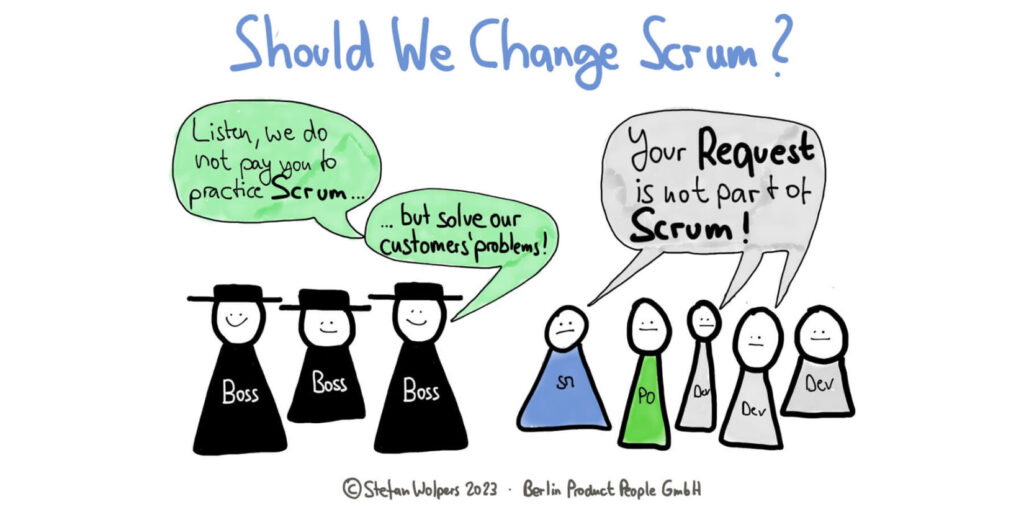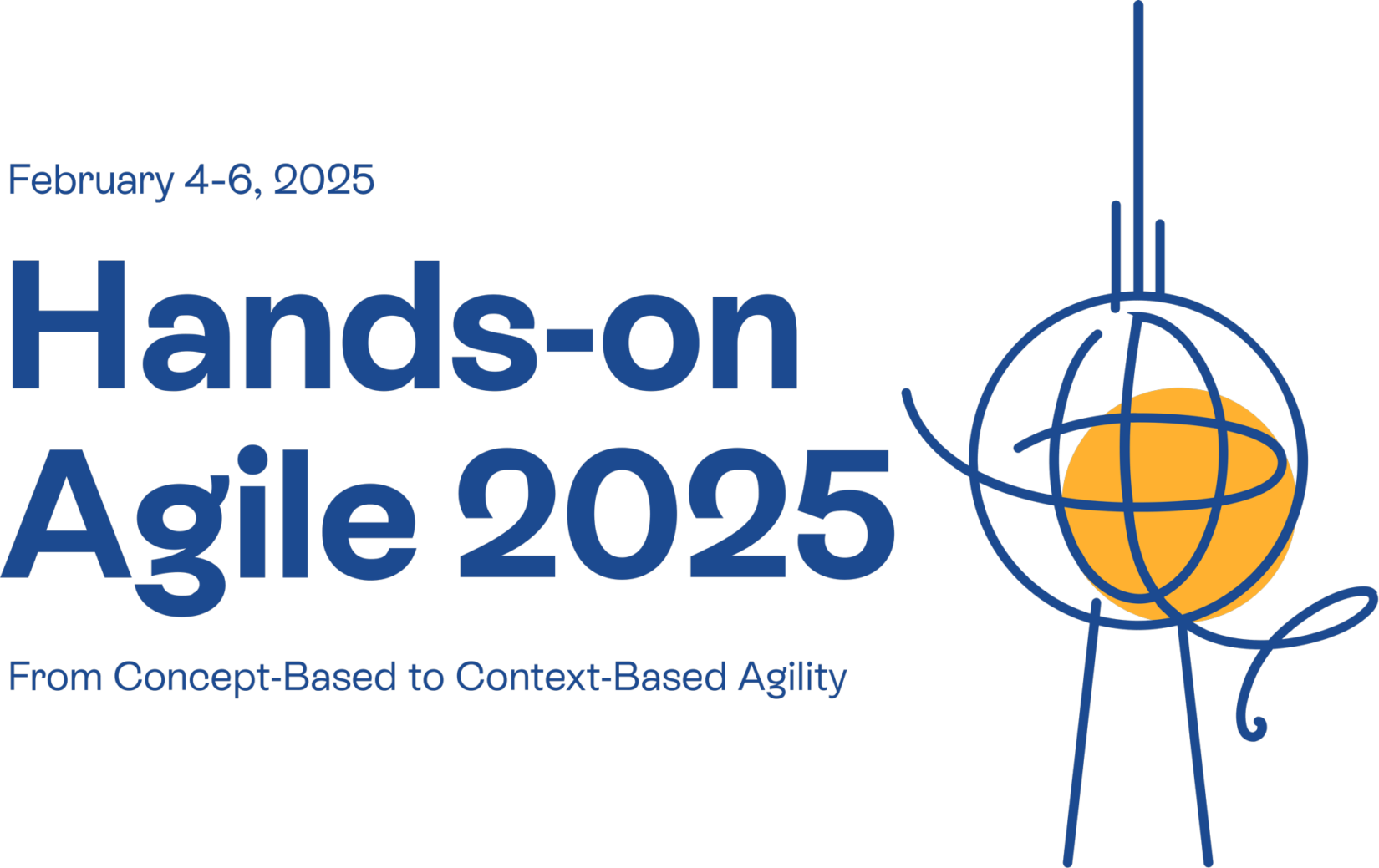TL; DR: Can We Or Should We Change Scrum?
Can we or should we change Scrum, or is it blasphemy to tweak the ‘immutable’ framework to accommodate our teams’ and organizations’ needs?
Not so fast; don’t just dismiss augmenting Scrum as leaving the path, contributing to the numerous Scrumbut mutations, giving Scrum a bad name. However, in our rapidly evolving business landscape, sticking rigidly to traditional Scrum by the book could be a straightjacket stifling innovation, user focus, and adaptability.
From ensuring cultural compatibility to facing technical debt challenges and emerging technologies, discover ten compelling reasons why augmenting Scrum isn’t just okay—it’s necessary for modern teams.
Read on to discover when and how to adapt Scrum responsibly without diluting its essence.
📖 Get notified when the Scrum Anti-Patterns Guide book is available!
🇩🇪 Zur deutschsprachigen Version des Artikels: Sollten wir Scrum anpassen?.
🏅 The most popular discussion on LinkedIn last week was: I recently analyzed 50+ #ScrumMaster job ads. Many showcased mean #AntiPatterns.
🗞 Shall I notify you about articles like this one? Awesome! You can sign up here for the ‘Food for Agile Thought’ newsletter and join 49,000-plus subscribers.
👉 Join 475-plus peers and help create the next edition of the Scrum Master Salary Report!
Reasons for Changing Scrum
There are multiple legitimate reasons why you may consider to change Scrum:
Business Complexity: Modern business complexity often exceeds standard Scrum’s scope. Organizations often face interdependencies among departments and other entities, third-party vendors, or regulatory bodies. Enhancing Scrum to consider these elements allows for a more holistic approach to solving customer problems sustainably.
Compliance and Regulation: In highly regulated industries, additional checks and balances are needed. Scrum can be augmented to meet compliance needs, for example, by specialized Developer roles responsible for ensuring that regulatory requirements are met.
Integrating with Other Methodologies: Many organizations employ multiple agile frameworks or methodologies. Modifying Scrum to better integrate with, for example, Kanban in maintenance projects or Design Thinking in early-stage product development can create a more cohesive, effective process flow.
Innovation: Scrum is designed for incremental improvement but isn’t necessarily geared for groundbreaking innovation. Incorporating elements that promote innovation, like “innovation Sprints” or hackathons, can add a new dimension to what Scrum teams can achieve.
Resource Constraints: Smaller organizations or teams with limited resources might find it challenging to follow Scrum by the book. Simplifying or tweaking Scrum elements can help organizations adopt agile practices without being overwhelmed.
Product Discovery: Scrum is often criticized for lacking explicit guidance on product discovery. Adding a discovery phase or supporting the Product Owner to focus on this aspect can ensure that the Scrum team is building the right product, not just building the product right.
User Experience Focus: Traditional Scrum doesn’t explicitly emphasize user experience (UX). But as UX gains importance in software development, there is a growing need to incorporate it within the Scrum framework, which means integrating user testing and design into the Sprint flow.
Data-Informed Decisions: Scrum emphasizes stakeholder feedback but doesn’t necessarily prescribe data-informed decision-making. Integrating data analytics into Scrum can help teams be more objective and precise in planning and execution. (Scrum.org points the way with its Evidence-Based Management approach.)
Remote Work Challenges: The recent surge in remote work brings its own set of challenges. Changing Scrum to adapt to remote team dynamics, such as asynchronous communication or tools for remote collaboration, is almost necessary.
When examined critically, each of these reasons to change Scrum shows that the framework, while robust, might only partially cover the array of challenges and opportunities product teams encounter. Consequently, as long as changes are made thoughtfully and respectfully to the framework’s first principles, a solid argument must be made for its augmentation.
Cannot see the form? Please click here.
Conditions for Changing Scrum
Let’s delve deeper into the conditions under which changing Scrum could be deemed acceptable:
Holistic View: No changes should not be made in isolation. We must consider how a change in one area might impact others. A holistic view ensures that modifications to Scrum are coherent and synergistic rather than disruptive or conflicting.
Complete Understanding of Scrum Principles: Before making any changes to Scrum, it’s crucial to thoroughly understand its core principles and practices. A solid grasp ensures that any adjustments made will not undermine the fundamental tenets of Scrum.
Organizational Alignment: The change should not only benefit the Scrum team but should also be in line with the larger organizational strategy. Disconnection between the Scrum team’s practices and organizational objectives can result in friction and hamper customer value creation.
Customer-Centric: The change should be aligned with the ultimate goal of delivering more value to the customer. If a proposed alteration does not improve the product or make the process more customer-centric, the change needs reversal.
Ethical & Legal Compliance: Changes should not introduce practices that violate legal or ethical guidelines, including labor laws, industry regulations, and corporate governance guidelines.
Clear Objectives: Any change should have a clear, well-defined objective to solve a specific problem or improve an aspect of the workflow. This objective should be measurable and aligned with the overall goals of the project or the organization.
Team Consensus: Scrum emphasizes collective decision-making. The team should discuss and agree upon any changes to the framework.
Iterative Experimentation: The Scrum team or teams should test any significant changes in a smaller scope before implementing them to gauge their effectiveness. An experimental approach allows for modifications and quick reversals if the change proves to be ineffective or detrimental.
Data-Backed Rationale: The Scrum teams should use empirical data to justify the change. For example, employ stakeholder satisfaction surveys post-release to justify modifications in stakeholder engagement practices, ensuring that the developed product aligns well with stakeholder expectations and organizational objectives.
Review & Feedback: A team should review the situation regularly to assess its impact after implementing a change. The review would include feedback from all team members and stakeholders to evaluate the effectiveness of the previous change. Consequently, the team needs to reverse any ineffective changes.
So, there are legitimate reasons to change Scrum, and we can define conditions that will support a change while respecting Scrum’s first principles.
Let’s Change Scrum
Now, let us navigate nuanced Scrum augmentations to suit organizational contexts better, addressing ten issues to uphold agile principles amidst varied operational scenarios:
Leadership Buy-in: Leadership’s endorsement is crucial for any change in practice to be accepted and implemented effectively. You might need to adapt Scrum practices to meet certain management expectations or to secure resources, but this should never compromise agile principles. Demonstrating the ROI of proposed changes can be instrumental in gaining leadership support. (Example: Including a governance entity in the release process.)
Cultural Compatibility: Organizations with unique cultures might not naturally align with Scrum’s principles. Tweaking the framework to fit an organization’s cultural norms isn’t about undermining Scrum’s integrity but ensuring its applicability and acceptability across diverse work environments. (Example: Creating a Sprint report next to having a Sprint Review.)
Psychological Safety: A psychologically safe environment is crucial for team members to take risks, make mistakes, and learn from them. Though Scrum implies this through its emphasis on collaboration and respect, making it explicit through regular check-ins or specific team agreements can cement this critical aspect of agile work environments.
Stakeholder Engagement: Scrum mentions the roles of the Product Owner and the Developers but leaves stakeholder engagement rather vague. Expanding Scrum to include customer feedback loops or internal stakeholder check-ins can add another layer of validation and alignment, ensuring that the product development is more in tune with end-user needs and organizational goals. (Example: Including stakeholders in Product Backlog management issues; for example, with User Story Mapping exercises.)
Scalability Concerns: Scrum alone doesn’t offer guidance on operating at scale. Frameworks like Nexus and LeSS have provided their interpretations of scaled agility, which involve significant modifications to vanilla Scrum. Understanding when and how to use such frameworks requires an analysis of the specific organizational context. (Note: I do not consider SAFe® a suitable way of scaling Scrum.)
Global Teams: In a worldwide setup, time zones, language, and cultural nuances can throw several challenges. Modifying Scrum to include asynchronous Daily Scrums or creating overlapping “core hours” where the whole team is available can be beneficial. These adjustments allow for smoother collaboration and effective communication among distributed team members. (Note: Scrum addresses primarily a single, co-located team.)
Technical Debt: The accumulation of technical debt can stall progress and compromise quality. While Scrum doesn’t explicitly deal with this, modifying the framework to include dedicated time for resolving technical debt during each Sprint can create a healthier, more sustainable codebase. This allows teams to maintain a balance between feature delivery and code quality, thereby mitigating future risks.
Emerging Technologies: As technology evolves rapidly, Scrum teams must adapt to incorporate new tools and techniques. Whether integrating data analytics into the Product Backlog prioritization process or incorporating AI-based testing tools, the framework should be flexible enough to accommodate technological advancements without losing its essence. (Note: Technical R&D should regularly be part of every Sprint.)
Feedback Loops Beyond Retrospectives: Scrum relies heavily on Retrospectives for feedback. However, continuous feedback mechanisms focused on improvement, peer reviews, or customer validation loops could supplement the Retrospectives. Adding different feedback opportunities ensures that insights and improvements are ongoing rather than confined to Sprint boundaries, encouraging real-time growth and adaptation. (Example: Entertain occasional yet regular stakeholder and team Retrospectives.)
Skill Set Diversification: For teams that still need to become cross-functional, consider adaptations to the Scrum framework to account for learning curves, upskilling, pairing with experts, and overcoming or compensating for organizational design debt. This proactive approach ensures that the team becomes truly self-sufficient over time. (Example: Overcoming the separation of user research or quality assurance from Scrum teams.)
Each of these aspects offers a rich area for exploration and adaptation, and aligning them carefully with the core tenets of Scrum can ensure a more holistic, hands-on application of the framework.
When Not to Change Scrum
Finally, let’s have a look at change anti-patterns—the four main reasons not to tinker with Scrum’s process:
Impatience for Quick Wins: Scrum is not a silver bullet but a framework that facilitates a particular process and culture. Adopting Scrum requires a period of adjustment and learning. Organizations or teams impatient for immediate results might tinker with the framework to expedite outcomes. This kind of impatience can lead to cutting corners, which often undermines the principles of Scrum and can result in long-term failures or sub-standard performance.
Fundamental Misunderstanding: This comes from either not fully grasping the principles of Scrum or misconceiving it as a project management tool rather than a product development framework. When changes are made from the point of misunderstanding, they can dilute the essence of Scrum, leading to a mishmash of practices that defy the core tenets of agility, transparency, and collaboration.
Personality-Driven Changes: In some teams, influential individuals or subgroups might push for changes that cater to their preferences or working styles rather than considering the team’s or project’s best interests. These personality-driven changes can lead to an uneven distribution of power or responsibility, eroding the collaborative fabric essential for Scrum.
Trend Following or Buzzword Compliance: The agile world is not immune to trends and buzzwords. Whether it’s new roles, tools, or practices, there’s always something that’s capturing the industry’s imagination. Integrating these trends without critical evaluation can result in a confusing hybrid of methods that lack coherence. It can turn Scrum into an unrecognizable patchwork that fails to improve value creation and will likely introduce new problems.
Understanding what not to do is equally as important as knowing what to do. Before you change Scrum, it’s crucial to evaluate whether the motivation behind the change is aligned with solving real problems and improving the process rather than stemming from one of these change anti-patterns.
Conclusion
Let’s not romanticize Scrum as some untouchable monolith; it’s a tool, not a religion. We’re not paid to do Scrum; we’re paid to deliver value and solve complex adaptive problems. In a constantly evolving world, our approaches to problem-solving and value delivery need to change, too.
While the Scrum framework has proven remarkably resilient and effective, it is not a one-size-fits-all solution. It’s important to remember that Scrum serves the team, the product, and the organization in this sequence—not the other way around.
The ultimate goal isn’t to implement Scrum perfectly but to solve real problems for real people in the most effective way possible. This sometimes requires adapting Scrum to fit our unique contexts better. What’s crucial is that any changes are made with a complete understanding of Scrum’s first principles so that we respect its essence while leveraging its structure for even greater success.
So, don’t be afraid to innovate, adapt, and iterate—not just your product but also your process.
Related Articles
Agile Failure Patterns in Organizations 2.0.
Resistance to Agile Transformations: Reasons and How To Overcome Them.
Minimum Viable Library (3) — Agile Leadership Edition.
Download the Scrum Anti-Patterns Guide for free.
📅 Agile Leadership: Scrum Training Classes, Workshops, and Events
Learn more about how to change Scrum with our Scrum training classes, workshops, and events. You can secure your seat directly by following the corresponding link in the table below:
Date
Class and Language
City
Price
🖥 💯 🇬🇧 October 10, 2023
GUARANTEED: Hands-on Agile #54: Product Backlog Management Traps — David Pereira (English; Live Virtual Meetup)
Live Virtual Class
FREE
🖥 💯 🇩🇪 November 1-2, 2023
GUARANTEED: Professional Scrum Master Training (PSM I; German; Live Virtual Class)
Live Virtual Class
€1.189 incl. 19% VAT
🖥 🇩🇪 November 21-24, 2023
Professional Scrum Product Owner Training (PSPO I; German; Live Virtual Class)
Live Virtual Class
€1.189 incl. 19% VAT
🖥 💯 🇬🇧 November 28, 2023
GUARANTEED: Professional Scrum Facilitation Skills Training (PSFS; English; Live Virtual Class)
Live Virtual Class
€749 incl. 19% VAT
🖥 🇩🇪 December 11-12, 2023
Professional Scrum Master Training (PSM I; German; Live Virtual Class)
Live Virtual Class
€1.189 incl. 19% VAT
🖥 🇩🇪 December 13-14, 2023
Professional Scrum Product Owner Training (PSPO I; German; Live Virtual Class)
Live Virtual Class
€1.189 incl. 19% VAT
🖥 🇩🇪 December 18-19, 2023
Professional Scrum Master (Advanced) Training (PSM II; German; Live Virtual Class)
Live Virtual Class
€1.189 incl. 19% VAT
See all upcoming classes here.
You can book your seat for the training directly by following the corresponding links to the ticket shop. If the procurement process of your organization requires a different purchasing process, please contact Berlin Product People GmbH directly.
✋ Do Not Miss Out and Learn more about how to Change Scrum — Join the 19,000-plus Strong ‘Hands-on Agile’ Slack Community
I invite you to join the “Hands-on Agile” Slack Community and enjoy the benefits of a fast-growing, vibrant community of agile practitioners from around the world.
If you like to join all you have to do now is provide your credentials via this Google form, and I will sign you up. By the way, it’s free.
Support your team’s efforts to change Scrum by pointing to the free Scrum Anti-Patterns Guide:
The post Should We Change Scrum? appeared first on Age-of-Product.com.





